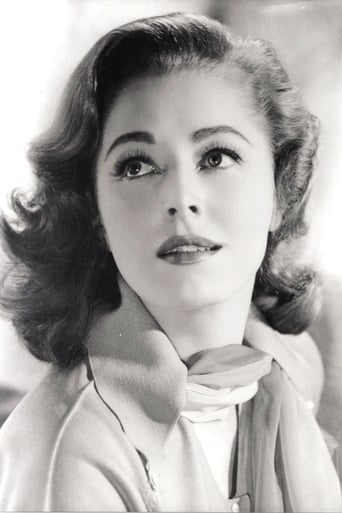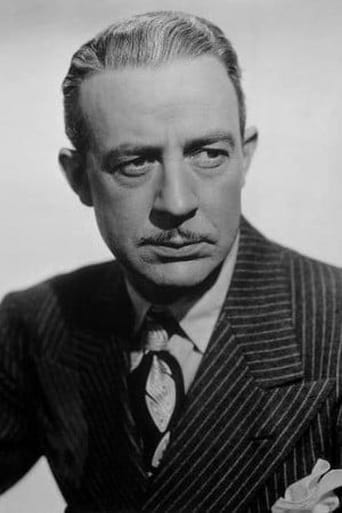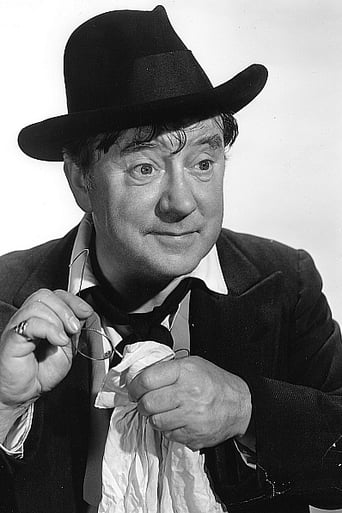dbborroughs
Beginning with a truly stunning image- what appears to be a headless corpse walking along the foggy moors, this is a neat little wartime thriller about the weird goings on in a small English village that has had the local tin mine shut down because of weird visions-headless visions- and the tragedies that strike those who go in the mine. ASolidly enjoyable hour long film this has mood to burn. As my friend Lou says about the film "it has everything you'd put on a list of things you need for a great 'old dark house film'". I agree. While the film isn't perfect, the mood has to be shifted to one side because there is, after all a plot, its still a great film to watch on a dark and stormy night or late at night curled up under the covers.
zardoz-13
"The Mysterious Doctor" was a Warner Brothers' World War II era propaganda B-movie that entwined horror and espionage. Originally entitled "The Mystery Doctor," this mild horror chiller whodunit was helmed by "Secret Enemies" director Ben Stoloff between August 13, 1942, and late September 1942. "G.I. Honeymoon" scenarist Richard Weil penned the original screenplay. "The Mysterious Doctor" qualifies as a solid melodrama with an adequate cast, and richly atmospheric sets and surroundings. Initially, the plot seems pretty minor, but you have to remember that B-movies rarely lasted no more than an hour, and Warner Brothers designed this movie to make our British allies look good. Despite its small potatoes storyline, the movie takes on added significance when you study its production history within the context of Hollywood censorship and Federal censorship.Posing as a man the British Army has rejected for active duty, a mining engineer, Dr. Frederick Holmes (Lester Matthews of "Jungle Man-Eaters"), takes a week-long walking trip through Cornwall. The first time that we see Dr. Holmes, he is tramping about the foggy moors after dark and catches a ride with a peddler (Harold De Becker of "Crime Doctor") to Morgan's Head. He wants to know why local miners refuse to work a tin mine that could yield a valuable asset to the English war effort. Holmes learns that the villagers are not working the mine because they fear the ghost of a headless man who haunts the moors and the mine. Eventually, the engineer exposes the ghost as a hoax. As it turns out, the village benefactor, Sir Harry Leland (John Loder of "The Gorilla Man"), has been masquerading as the headless ghost. Sir Harry explains that he is the offspring of German nobility who came over back in the days of King George to supervise other Germans in the tin mines of Cornwall. He has turned the superstitious fears of the villagers against them to keep the mine out of operation. Sir Harry shoots a simple-minded villager who rushes him. Sir Harry attacks Holmes, they struggle, and Sir Harry falls onto knife and dies.The Production Code Administration served as the Hollywood censorship organization. The PCA file on "The Mysterious Doctor" contains only one letter, an Analysis Chart, and a certification of release permit. In his August 6, 1942, letter, Joseph Breen warned Warner Brothers to exercise restraint in "the gruesomeness and horror angles of this story, not only from the angle of the Production Code, but also from the angle of political censorship." He warned the studio never to show the village alcoholic Hugh Penhryn as "offensively drunk, although he may be suggested as a bit high." Breen cautioned them about the mentally challenged character of Bart Redmond, "If he is indicated as being insane, it is possible that the British Board of Film Censors will delete the scenes in which he appears." Another "Mysterious Doctor" character named Simon, who owns the local inn and tavern, wears a black executioner's hood to conceal a face horribly scarred from an accident involving dynamite. The censor advocated "restraint be exercised as to the gruesomeness appearance of Simon." Breen also warned Warner Brothers about the mob scene when the unruly village children heckle Bart, because some political censor broads would cut them. Finally, the chief PCA censor instructed the filmmakers to suggest out of frame the business of a character being "clunked" over the head. Warner Brother bowed to Breen's demands in each instance, based on the final version of "The Mysterious Doctor" that received its certification of approval on October 15, 1942."The Mysterious Doctor" file in the U.S. Government's Office of War Information film collection at the National Archives in Maryland contained only the Feature Viewing analysis. The agency judged "The Mysterious Doctor" as "an average horror story which has been filmed against a timely background of England at war." Although the analysts admitted that the film presented a few useful points to Washington's war information program, they observed that it could have told its story without any reference to the war. The OWI took the filmmakers to task for their failure to examine either Nazi ideology or the greater issues of the war. As "another example of the use of the war as a backdrop for a melodramatic story," "The Mysterious Doctor" made only minor contributions to the OWI's war information program. The officials complemented the film for (1) its emphasis on the importance of raw materials to the war effort, (2) that everyone should contribute in some way to the war, (3) its images of an England at work, (4) the timely importance of raw materials geared to war production without delay, and (5) "a partial recognition of what is a stake in this war." The analyst lamented, however, that Warner Brothers offset all these positive contributions because "The Mysterious Doctor" "casts suspicion unnecessarily on all person of German descent." According to the OWI, this story element impugned the loyalty of millions of British and Americans whose ancestors hailed from Germany. Worse, the analyst argued, this ideology gave a false impression of the enemy. The OWI echoed their own ideology from the Government Information Manual, "We are not fighting Germans unto the fourth and fifth generation; we are fighting a system of force and militarism which threatens to enslave the earth."Director Ben Stoloff generates atmosphere, suspense, and mystery with "The Mysterious Doctor." The only real flaw is the surprise at the end when we learn that the fellow whose face had been blown off was a plot contrivance so that the hero could work undercover. The headless fiend outfit is pretty neat.
MartinHafer
This was a truly bizarre little British propaganda film made during the Second World War. It's so odd because it looks initially like a B-movie horror film (with talk about ghosts and headless ghouls walking about), but then unexpectedly becomes an anti-Nazi film about German attempts to destroy tin production in Britain!! Talk about strange plot-twists! However, despite the creativity of the plot, the film has quite a few problems that prevent it from being anything more than a silly time-passer. One problem, and it is relatively minor, is that the whole gimmick of the guy with a hood over his head is just silly. He didn't look all that bad without it and it's frightfully easy to guess what they would do with that character. A much bigger problem is that there really isn't much mystery about the film because it is just way too rushed. The suspense is never given a chance to build and the film makers were obviously too constrained by the unwritten rule that B-movies should be 50-70 minutes long,...period! And in this case, this meant ill-developed plot elements and a way too quickly solved mystery. As a result, the film never really jells into a coherent or memorable film. Nice try, though, but a film that is very skip-able.
Eric Chapman
A few chills and some decent atmosphere (atmosphere usually meaning fog) but the modest storyline takes a back seat to war time "rally 'round the troops, boys" sentiment. Seen with that in mind it does possess a certain degree of charm. I like the early shot of the mysterious headless "ghost" wandering through the fog, but it rather quickly becomes apparent that there is a very earth-bound, prosaic explanation. It's all a bit of a mess of course, but quite understandably America and Great Britain had more important things on their mind at the time. Eleanor Parker is porcelain beautiful in one of her early roles.





